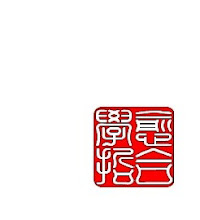 The Chinese way of writing in pictures has always held a beautiful mystery and a fascination for me but remains one of my unfulfilled desires for exploration and study. And as a part of the Chinese way of writing, the use of seals is perhaps the most beautiful and the most mysterious aspect.
The Chinese way of writing in pictures has always held a beautiful mystery and a fascination for me but remains one of my unfulfilled desires for exploration and study. And as a part of the Chinese way of writing, the use of seals is perhaps the most beautiful and the most mysterious aspect.The Chinese have been using seals for three thousand years and their use continues to this day in business and in private life. The earliest examples of seals date from the Shang Dynasty (16-11 BC) but they were in use long before. According to a Han dynasty tradition, the first seal was given to the Yellow Emperor by a yellow dragon. The significance of the seal was to confer the Mandate of Heaven on the rightful ruler of the empire. (You can read an interesting overview here).
Looking further into the background of Chinese seals, I discovered the story of the Heirloom Seal, or the Imperial Seal of China, which has all the trappings of an epic Hollywood movie. You can read about it here at Wikipedia. In short, the seal was created in 221BC and passed down through the ages as dynasties rose and fell. Wars were fought for ownership of the seal as it was believed to confer legitimacy on the regime that possessed it, and history has proven them generally right. The seal was eventually lost in the Five Dynasties and Ten Kingdoms period (907=960).
Now what has all this got to do with philosophy? Well, to me, anything that confers the Mandate of Heaven is well worth looking into! Seriously, there is a power in these things that we can appropriate for ourselves. And if you think I am full of it, I will just ask you to consider the following:
1 - He is able who thinks he is able, said Buddha. That stone, that relic, that object is sacred and holy because we say it is sacred and holy and act accordingly. That thing or that person is powerful, fearsome, hated or beloved who we believe to be so. Things and people have the power and the qualities that we ascribe to them. (See my post The power of the subconscious mind). So it is with seals.
2 - Modern-day corporations spend millions of dollars designing, publicizing and protecting their logos, a modern form of seals or heraldry. Why?
3 - Hitler knew exactly what he was doing when he appropriated the sacred swastika as his emblem for the Nazi party. In the same vein, Churchill ordered that German submarines be referred to always as ‘U-Boats’, thus ‘branding’ them as something distinct from and far more sinister than ‘our submarines’.
So how can we appropriate the power of symbols or seals in our life today?
First you need a seal. If you have ever studied Chinese painting you may already have your seal. (I am here to tell you that affixing your seal on a painting that you have just created is a thrilling yet solemn occasion). You can have a seal made online or, depending where you live, at your local Chinatown. For online virtual use, I discovered a fun little site at Chinese Tools. Here you can translate your name into Chinese characters and then copy the characters into a tool that creates your Chinese name seal. That is where I got the seal you see in my profile, meaning ‘Alex’. You can also translate a phrase, which is what I did to get the seal at the bottom of the right-hand column, which means ‘Healing philosophy’.
Once you have a seal, you can then use it as a symbol of personal power, a talisman, and an invocation. When setting goals, don’t just write them down. Sign them with your ‘seal of power’. But make sure you follow through. Treat your seal seriously. If you are not absolutely serious about completing the goal, don’t use the seal. Any failure to follow through will weaken the power of the seal. The seal will only have that power that you confer upon it through repeated successful use. But once that power is conferred, it will be embodied in the seal and seem to take on a power of its own. Increase your seal’s power by using it on everything good and beautiful that you create, on every successful project. Use it on your best letters. Sign your checks with it (OK maybe not).
Of course, all this will only resonate with you if you are into Eastern culture. If not, perhaps a heraldic symbol would work better for you, or a Christian symbol. Choose the symbol that appeals to you, one that will feel at home in your subconscious. For it is the power of the subconscious that we are invoking here, which is our link to the power of the universal. The same power that conferred the Mandate of Heaven on the Yellow Emperor.
.
Image from Wikimedia: Seal of the Mongol ruler Ilkhan Ghazan, over the last two lines of his 1302 letter to Pope Boniface VIII. The seal reads "Seal certifying the authority of his Royal Highness to establish a country and govern its people"







No comments:
Post a Comment